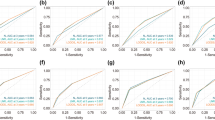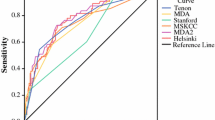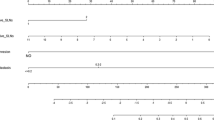Abstract
Background
The sentinel lymph node (SLN) procedure could be omitted in cases of accurate prediction of very high or very low probability of SLN metastasis in early breast cancer patients. We evaluated a breast cancer nomogram, an online tool provided by the Memorial Sloan–Kettering Cancer Center (MSKCC), that predicts the likelihood of a positive lymph node.
Methods
Data from 545 patients with successful SLN biopsy were collected, including 118 patients with a positive sentinel lymph node. Histopathological assessment of the SLN included hematoxylin and eosin staining and/or immunohistochemistry. Predictive accuracy was assessed by calculating the area under the receiver–operator characteristic (ROC) curve.
Results
In our collective tumor size, histology, lymphovascular infiltration, multifocality, Her-2-neu positivity, and nuclear grade correlated with the probability of SLN metastasis. The ROC of the validated nomogram in our breast cancer population revealed a value of 0.78 compared with 0.75 in the original publication.
Conclusion
The MSKCC nomogram is a useful tool in our population of breast cancer patients. However, variations in the pathological assessment of the SLN between breast cancer centers worldwide might be an impediment to widespread application of the nomogram.


Similar content being viewed by others
References
Krag D, Weaver D, Ashikaga T, Moffat F, Klimberg VS, Shriver C, et al. The sentinel node in breast cancer-a multicenter validation study. N Engl J Med. 1998;339:941–6.
Giuliano AE, Kirgan DM, Guenther JM, Morton DL. Lymphatic mapping and sentinel lymphadenectomy for breast cancer. Ann Surg. 1994;220:391–398; discussion 398–401.
Veronesi U, Paganelli G, Galimberti V, Viale G, Zurrida S, Bedoni M, et al. Sentinel-node biopsy to avoid axillary dissection in breast cancer with clinically negative lymph-nodes. Lancet. 1997;349:1864–7.
Veronesi U, Paganelli G, Viale G, Luini A, Zurrida S, Galimberti V, et al. Sentinel-lymph-node biopsy as a staging procedure in breast cancer: update of a randomised controlled study. Lancet Oncol. 2006;12:983–90.
Mansel RE, Fallowfield L, Kissin M, Goyal A, Newcombe RG, Dixon JM, et al. Randomized multicenter trial of sentinel node biopsy versus standard axillary treatment in operable breast cancer: the ALMANAC Trial. J Natl Cancer Inst. 2006;9:599–609.
Langer I, Guller U, Berclaz G, Koechli OR, Schaer G, Fehr MK, et al. Morbidity of sentinel lymph node biopsy (SLN) alone versus SLN and completion axillary lymph node dissection after breast cancer surgery: a prospective Swiss multicenter study on 659 patients. Ann Surg. 2007;245:452–61.
Choong PL, deSilva CJ, Dawkins HJ, Sterrett GF, Robbins P, Harvey JM, et al. Predicting axillary lymph node metastases in breast carcinoma patients. Breast Cancer Res Treat. 1996;37:135–49.
Voogd AC, Coebergh JW, Repelaer van Driel OJ, Roumen RM, van Beek MW, Vreugdenhil A, et al. The risk of nodal metastases in breast cancer patients with clinically negative lymph nodes: a population-based analysis. Breast Cancer Res Treat. 2000;62:63–9.
Barth A, Craig PH, Silverstein MJ. Predictors of axillary lymph node metastases in patients with T1 breast carcinoma. Cancer. 1997;79:1918–22.
Shoup M, Malinzak L, Weisenberger J. Predictors of axillary lymph node metastasis in T1 breast carcinoma. Am Surg. 1999;65:748–52; discussion 752–3.
Viale G, Zurrida S, Maiorano E, Mazzarol G, Pruneri G, Paganelli G, et al. Predicting the status of axillary sentinel lymph nodes in 4351 patients with invasive breast carcinoma treated in a single institution. Cancer. 2005;103:492–500.
Caywood J, Gray RJ, Hentz J, Pockaj BA. Older age independently predicts a lower risk of sentinel lymph node metastasis in breast cancer. Ann Surg Oncol. 2005;12:1061–5. Epub 2005 Oct 21.
Giuliano AE, Jones RC, Brennan M, Statman R. Sentinel lymphadenectomy in breast cancer. J Clin Oncol. 1997;15:2345–50.
Nathanson SD, Slater R, Debruyn D, Kapke A, Linden M. Her-2/neu expression in primary breast cancer with sentinel lymph node metastasis. Ann Surg Oncol. 2006;13:205–13.
Bevilacqua JL, Kattan MW, Fey JV, Cody HS 3rd, Borgen PI, Van Zee KJ. Doctor, what are my chances of having a positive sentinel node? A validated nomogram for risk estimation. J Clin Oncol. 2007;25:3670–9. Epub 2007 Jul 30.
Van Zee KJ, Manasseh DM, Bevilacqua JL, Boolbol SK, Fey JV, Tan LK, et al. A Nomogram for predicting the likelihood of additional nodal metastasis in breast cancer patients with a positive sentinel node biopsy. Ann Surg Oncol. 2003;10:1140–51.
Gipponi M, Bassetti C, Canavese G, Catturich A, Di Somma C, Vecchio C, et al. Sentinel lymph node as a new marker for therapeutic planning in breast cancer patients. J Surg Oncol. 2004;85:102–11.
Varghese P, Mostafa A, Abdel-Rahman AT, Akberali S, Gattuso J, Canizales A, et al. Methylene blue dye versus combined dye-radioactive tracer technique for sentinel lymph node localisation in early breast cancer. Eur J Surg Oncol. 2007;33:147–52.
Florkowski CM. Sensitivity, specificity, receiver-operating characteristic (ROC) curves and likelihood ratios: communicating the performance of diagnostic tests. Clin Biochem Rev. 2008;29 (Suppl 1):S83–7.
Hosmer DW, Lemeshow S. Applied logistic regression, 2nd ed. New York: Wiley; 2000.
Katz A, Smith BL, Golshan M, Niemierko A, Kobayashi W, Raad RA, et al. Nomogram for the prediction of having four or more involved nodes for sentinel lymph node-positive breast cancer. J Clin Oncol. 2008;26:2093–8.
Kohrt HE, Olshen RA, Bermas HR, Goodson WH, Wood DJ, Henry S, et al., on behalf of the Bay Area SLN Study. New models and online calculator for predicting non-sentinel lymph node status in sentinel lymph node positive breast cancer patients. BMC Cancer. 2008;8:4–66.
Degnim AC, Reynolds C, Pantvaidya G, Zakaria S, Hoskin T, Barnes S, et al. Nonsentinel node metastasis in breast cancer patients: assessment of an existing and a new predictive nomogram. Am J Surg. 2005;190:543–50.
Kocsis L, Svébis M, Boross G, Sinkó M, Maráz R, Rajtár M, et al. Use and limitations of a nomogram predicting the likelihood of non-sentinel node involvement after a positive sentinel node biopsy in breast cancer patients. Am Surg. 2004;70:1019–24.
Alran S, De Rycke Y, Fourchotte V, Charitansky H, Laki F, Falcou MC, et al. Institut Curie Breast Cancer Study Group Validation and limitations of use of a breast cancer nomogram predicting the likelihood of non-sentinel node involvement after positive sentinel node biopsy. Ann Surg Oncol. 2007;14:2195–201.
Klar M, Jochmann A, Foeldi M, Stumpf M, Gitsch G, Stickeler E, et al. The MSKCC nomogram for prediction the likelihood of non-sentinel node involvement in a German breast cancer population. Breast Cancer Res Treat. 2008;112:523–31.
Lambert LA, Ayers GD, Meric-Bernstam F. Validation of a breast cancer nomogram for predicting nonsentinel lymph node metastases after a positive sentinel node biopsy. Ann Surg Oncol. 2007;8:2422–3.
Cripe MH, Beran LC, Liang WC, Sickle-Santanello BJ. The likelihood of additional nodal disease following a positive sentinel lymph node biopsy in breast cancer patients: validation of a nomogram. Am J Surg. 2006;4:484–7.
Cserni G. Evaluation of sentinel lymph nodes in breast cancer. Histopathology. 2005;46:697–706.
Cserni G, Amendoeira I, Apostolikas N, et al. Discrepancies in current practice of pathological evaluation of sentinel lymph nodes in breast cancer. Results of questionnaire-based survey by the European Working Gourp for Breast Screening Pathology. J Clin Pathol. 2004;57:695–701.
Perry N, Broeders M, de Wolf C, et al. (editors). European guidelines for quality assurance in mammography screening, 3rd ed. Luxemburg: European Communities; 2001.
Kuehn T, Bembenek A, Buechels H, et al. Sentinel lymph node biopsy in breast cancer. A national concept for the clinical implementation of sentinel lymph node biopsy (SLNB) in breast cancer patients with special regard to quality assurance. Cancer. 2005;103:451–61.
Author information
Authors and Affiliations
Corresponding author
Rights and permissions
About this article
Cite this article
Klar, M., Foeldi, M., Markert, S. et al. Good Prediction of the Likelihood for Sentinel Lymph Node Metastasis by Using the MSKCC Nomogram in a German Breast Cancer Population. Ann Surg Oncol 16, 1136–1142 (2009). https://doi.org/10.1245/s10434-009-0399-3
Received:
Revised:
Accepted:
Published:
Issue Date:
DOI: https://doi.org/10.1245/s10434-009-0399-3




